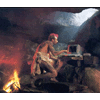Fwd: Anticipating the Future to ' See' the Present (NYT)
Wed, 11 Jun 2008 23:33:49 -0700
Bill Daul <bdaul [at] pacbell.net>

By BENEDICT CAREY
Staring at a pattern meant to evoke an optical illusion is usually an act of
idle curiosity, akin to palm reading or astrology. The dot disappears, or it
doesn't. The silhouette of the dancer spins clockwise or counterclockwise.
The three-dimensional face materializes or not, and the explanation always
seems to have something to do with the eye or creativity or even
personality.
That's the usual cue to nod and feign renewed absorption in the pattern.
In fact, scientists have investigated such illusions for hundreds of years,
looking for clues to how the brain constructs a seamless whole from the
bouncing kaleidoscope of light coming through the eyes. Brain researchers
today call the illusions perceptual, not optical, because the entire visual
system is involved, and their theories about what is occurring can sound as
exotic as anyone's.
In the current issue of the journal Cognitive Science, researchers at the
California Institute of Technology and the University of Sussex argue that
the brain's adaptive ability to see into the near future creates many common
illusions.
"It takes time for the brain to process visual information, so it has to
anticipate the future to perceive the present," said Mark Changizi, the lead
author of the paper, who is now at Rensselaer Polytechnic Institute. "One
common functional mechanism can explain many of these seemingly unrelated
illusions." His co-authors were Andrew Hsieh, Romi Nijhawan, Ryota Kanai and
Shinsuke Shimojo.
One fundamental debate in visual research is whether the brain uses a bag of
ad hoc tricks to build a streaming model of the world, or a general
principle, like filling in disjointed images based on inference from new
evidence and past experience. The answer may be both. But perceptual
illusions provide a keyhole to glimpse the system.
When shown two images in quick succession, one of a dot on the left of a
screen and one with the dot on the right, the brain sees motion from left to
right, even though there was none. The visual system has apparently
constructed the scenario after it has been perceived, reconciling the jagged
images by imputing motion.
In an experiment originated by Dr. Nijhawan, people watch an object pass a
flashbulb. The timing is exact: the bulb flashes precisely as the object
passes. But people perceive that the object has moved past the bulb before
it flashes. Scientists argue that the brain has evolved to see a split
second into the future when it perceives motion. Because it takes the brain
at least a tenth of a second to model visual information, it is working with
old information. By modeling the future during movement, it is "seeing" the
present.
Dr. Changizi and his colleagues hold that it is a general principle the
brain applies to a wide variety of illusions that trick the brain into
sensing motion.
"It's likely that there are many different neural mechanisms involved in
perceptual illusions," said Jacob Feldman, a Rutgers psychologist. "But the
idea that there may be some overarching explanation that accounts for these
separate mechanisms is compelling and satisfying to some scientists."
Timothy Hubbard, a psychologist at Texas Christian University, said the
principle of perceiving the present was sound, adding, "If a person's
response to an object, to catch, hit, block, whatever, is to be optimal,
that response should be calibrated to where the object would be"- not a
split second earlier, when the perception occurred.
This is why identical squares arranged around the center of a spoked-wheel
image appear misshapen, said Dr. Changizi, who writes about it in a book due
in 2009, "The Vision Revolution." The sides of squares closer to the center
appear to bulge. The sides farther out appear shorter. The radiating lines
in the pattern trick the brain into perceiving motion forward, so it
projects objects forward, making those nearer the center appear closer to
the eye.
The same effect can be seen by leaning forward toward a precise
checkerboard. The image seems to bulge forward, this time because the eyes
are moving.
Dr. Changizi says such illusions can also occur in real life. When a golf
ball or baseball rolls through the grass and suddenly drops into a hole, the
brain sometimes perceives a trace of the ball on the other side of the hole.
"But these are things that we don't experience very often," he said,
"because the brain is so good at covering up its mistakes."
June 10, 2008
Copyright 2008 The New York Times Company
http://www.nytimes.com/2008/06/10/health/research/10mind.html
Comment via email
Copyright © 2008 Bill Daul <bdaul [at] pacbell.net>






